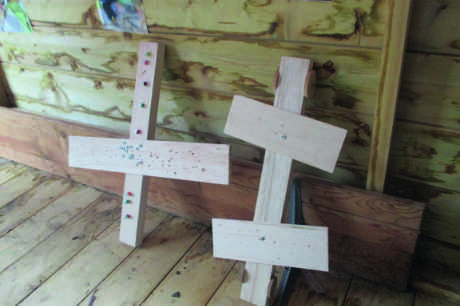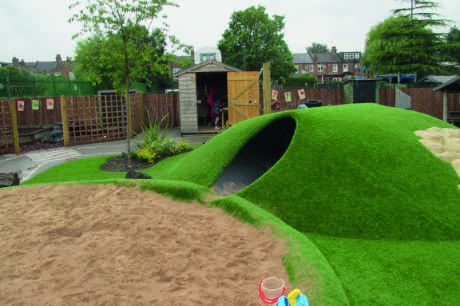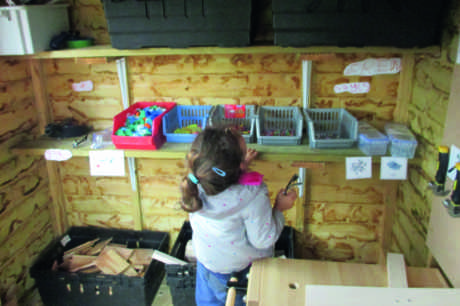
It’s raining and the playground at Belmont Infant School in the London Borough of Haringey is empty. But from inside a small shed opposite the classrooms, the regular sound of hammering is audible over the raindrops.
Inside, two children stand at a workbench. Peering through her plastic safety glasses, Cecilia from nursery bangs a nail with a hammer. Julie from Reception is making a model aeroplane. Reception class teacher Sophie Micallef stands by ready to help, but lets the children get on with their work independently.
As Cecilia decides to make a dash through the rain back to the classroom, Ms Micallef calls ‘Anthony!’ out of the door, reading off a long list of names waiting to take their turn. Anthony arrives, puts on the glasses, selects different lengths of wood from crates on the floor, and begins his craft determinedly.
Belmont introduced woodwork to its early years department last autumn, as part of an initiative with Haringey Council. ‘It was something we had been interested in doing for quite a while,’ says Belmont early years co-ordinator and Reception class teacher Ciara McGlacken. ‘We noticed an old tool bench in one of our storage cupboards. Ten or more years ago, woodwork was happening in quite a few schools in Haringey, but it got phased out because of health and safety concerns. We were keen to bring it back.’
At around the same time, Haringey Council early years advisory teacher Christina Kleanthous ran a woodwork workshop for teachers. ‘There was a lot of interest,’ she says. ‘People remembered doing it early in their careers, but it wasn’t around so much anymore. So, the project was born.’

DESIGNATED AREA
Ms Kleanthous secured council quality improvement funding worth £15,000 for a year to support 20 schools to introduce the activity. The funding provided tools and training for staff. Belmont and Bounds Green School operate as lead schools and staff received extra training, accompanying Ms Kleanthous to train the 18 other settings.
Each has set up their woodwork areas differently. Belmont converted an old storage shed into a designated area open for two hours every day during free-play times. Teachers introduced the activity in the classroom at first by passing around tools during circle times, and explaining how to use them safely.

‘We have a PowerPoint we used to introduce each tool to the whole class, small groups or individual children,’ says Ms McGlacken. ‘It means all children have heard the same language around it. Those same instructions go up in the woodwork shed, so people feel confident about what they’re doing.’
The presentation has also been shared among the participating schools. Health and safety is a key feature of the activity. The teachers keep a record of which tool every child has tried, and how confident they are using them independently.
The children use hammers, hand drills and bradawls to nail or screw together pieces of soft wood, make holes, and add beads and ribbons. Once children are more confident, the teachers plan to introduce a Japanese-style saw that is operated using two hands.
‘This has to be used one-to-one with a teacher,’ explains Ms McGlacken. ‘We’ve had lots of conversations about where hands should be and that eyes always need to be looking at what they’re doing.’
Only two children at a time are allowed to work in the shed, with one teacher supervising. Ms Micallef says this has worked well as it has helped children concentrate. In fact, one Reception-class boy who had problems with concentration in class was the first to make a model aeroplane. Since then, all the children are making aeroplanes.
‘I was surprised by him,’ Ms Micallef says. The same child has already told teachers of his plans to build a bird box. ‘He needs specific sizes of wood to do that, so we have to wait until we’ve introduced the saw,’ says Ms Micallef.
A GREAT INVESTMENT
Anthony is also making an aeroplane. The wings are finished, but now he needs to attach some wheels and is unsure of how many. Ms Micallef prompts him to think:if there are two wheels for each pair of wings, and he has two pairs of wings, what is double the number two? Anthony thinks, then exclaims, ‘Four!’ and reaches for the wheels. ‘Doubling is a class topic at the moment,’ Ms Micallef explains.
The exchange demonstrates the wide-ranging learning outcomes that woodwork can achieve. ‘Maths with shape, space and measure, communication and language, self-confidence and self-awareness…,’ lists Ms McGlacken. ‘It’s a brilliant investment.’
It also promotes the Characteristics of Effective Learning. Ms Kleanthous explains, ‘Woodwork gives the opportunity for children to set their own targets and manage how they follow them through. Children really rise to the challenge of using real equipment. Although it appears to be high risk, it is such a low-risk experience. It is all about staff knowing their children and how to introduce it individually where that might be needed.’
It has taken Anthony ten minutes to make his aeroplane. He skips back to his classroom clutching his creation, and classmate Raya takes his place. Sure enough, she also wants to make an aeroplane. At first it looks like its wings are going to be too short to fly. But with some guidance from Ms Micallef, she is soon constructing an aerodynamic invention and hammering away confidently. ‘I like it so much,’ she says.
For today, woodwork has come to an end and Ms Micallef announces it is tidy-up time. Raya’s plane is unfinished, but her teacher assures her she can return first thing tomorrow to finish it. The children diligently return their tools to designated hooks on the wall and place their safety goggles back on a shelf.
PARENT SUPPORT
When the scheme began, Belmont informed parents of the project in the school newsletter, with a list of ways it would support children’s learning. ‘It’s incredibly important for parents to be on board with what their children are doing, but we also didn’t want it to be optional,’ says Ms McGlacken. ‘We haven’t had anyone come back with any concerns.’
Amy Ritman, mother of Isaac in nursery, says the project has helped to develop her son’s interest in construction. ‘He came home and started telling me about using a bradawl. I didn’t know that word before!’ she says. ‘He has plastic tools at home but now he talks about using real tools. It’s a really practical and applicable addition to the curriculum.’
Nursery pupil Georgia received a woodwork set for her birthday from her parents as a result of her enthusiasm for the activity. ‘She has loved building all the models and now has new furniture for her doll’s house all made by her,’ says her mother, Emily Unsworth.
Woodwork expert Pete Moorhouse, whose books guided the project at Belmont, says children need to be exposed to experiential learning more than ever. ‘We’re dealing with a new generation who are so immersed in a screen-based existence,’ he says. ‘To get them to do something more physical, to problem-solve, is a really important part of education.’
INTRODUCING WOODWORK
Woodwork expert Pete Moorhouse advises early years practitioners:
Give children a safe introduction to the main tools. Don’t just explain how to use them – have a thorough dialogue about potential hazards.
Once children are confident with the tools, let them make what they want. This will give them motivation to persevere when using what is an awkward medium, compared to things like clay and cardboard.
Do not introduce too much challenge too soon. Start with soft balsa wood and small nails, then progress onto pine and larger nails.
Fence off your woodwork area to protect younger children. Otherwise a table in the corner, or outside, is fine – you don’t need a work shed.
Only ever let children do sawing on a one-to-one basis and under adult supervision. Pull saws, which require the use of two hands, are recommended and should be stored in an elevated place.
Having the right tools makes a massive difference. Visit www.irresistible-learning.co.uk for recommendations and free resources.
MORE INFORMATION
- ‘Tooled up!’, ‘Under the hammer’ and ‘All about…woodwork’ by Pete Moorhouse and ‘Parent’s guide: early learning – woodwork’ are available at: www.nurseryworld.co.uk










